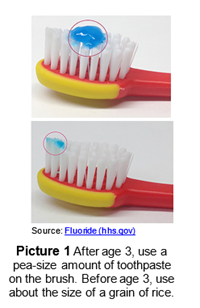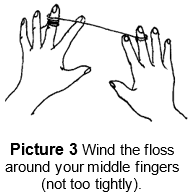Dental: Teeth and Gum Care
![]()
Healthy teeth and gums are very important to the health of your child. Teeth must be cleaned to remove food and plaque (plak). Plaque is a harmful layer of bacteria on the teeth that can cause cavities (tooth decay).
- Cavities happen faster in baby teeth than in adult (permanent) teeth.
- Brushing teeth should begin as soon as the first tooth comes in.
- To prevent cavities and gum disease, teeth, gums and tongue should be cleaned at least twice a day. It is good to brush teeth after meals, too.
How to Teach Your Child to Brush Their Teeth

- Younger children will need your help until they can brush their teeth properly by themselves. They can start to learn at age 2. By age 10, they should be able to do it alone.
- Use a small, soft toothbrush.
- Help your child learn to brush by having them watch you do yours first. Explain each of the following steps while
you brush your teeth and the two of you brush theirs.
- Put a small amount of fluoride toothpaste on the head (bristles) of the brush.
- For children age 3 and older, use a pea-size amount. For children 2 and younger, use about the size of a grain of rice (Picture 1).
- Brush only 2 to 3 teeth at a time. Angle the bristles along the inside of a row of teeth and against the gum line (Picture 2). Brush gently in circular motions. Brushing back and forth or too hard can hurt the gums and teeth.
 Brush the outside of a small group of teeth. Keep the bristles at an angle. Brush all sides of the teeth the same way.
Brush the outside of a small group of teeth. Keep the bristles at an angle. Brush all sides of the teeth the same way.- For inside of the front upper and lower teeth, put the head of the brush in a vertical (upright) position. Gently move the brush up and down over the teeth and gums.
- Finish by brushing the tongue with the toothbrush. This will help remove bacteria from the tongue and keep the breath fresh.
- When done, try to spit out the toothpaste. It is safe to swallow small amounts. Avoid rinsing after brushing so that the fluoride does not wash away.
Tooth Brushing Tips
- Replace the toothbrush at least every 3 months or if the bristles are frayed. A worn-out toothbrush will not clean your child's teeth well.
- Follow a routine of brushing every morning and before going to bed. Brush for 2 minutes each time. Make it fun by playing a favorite song for 2 minutes, by reading a book or by making up a story.
How to Use Dental Floss

Flossing should be done every day. It removes the layer of plaque that cannot be reached by a toothbrush. Begin flossing when your child's teeth are so close together that the sides touch. Like tooth brushing, it will take time and practice to do properly. Your child can learn to floss their teeth by age 11 or 12. To floss:
- Break off about 18 inches of floss and wind most of it around the middle finger of one hand. Wind the opposite end around the middle finger on the other hand (Picture 3). As you floss, the used or dirty floss will be wrapped around this second finger.
- Unwind about one inch of floss. Hold it firmly, without any slack, between two fingers. (Picture 4).

- Gently wiggle the floss down between the two teeth. Be careful to avoid going too fast and causing the floss to cut into the gums.
- When the floss reaches the gum line, wrap it around the front and back of one tooth so it is in a C-shaped curve (Picture 5). Always keep one finger behind the tooth that you are flossing and the other finger in front of that same tooth.
- Keep holding the floss firmly. Start below the gum line and slide the floss up and down the side of the tooth without cutting into the gums (Picture 5). Repeat this on the other side.
- To take the floss out, pull it up through the top between the teeth. If your child has braces, it might be easier to pull it through the space at the bottom between the teeth.
- Use a new section of clean floss when you move to the next space between the teeth.

- Repeat steps 2 through 7.
- Although not as good as regular floss, you can use flossers or floss picks to gently floss the teeth.
Other Things to Do to Prevent Tooth Decay
- dental checkups every 6 months
- healthy diet
- Be careful that your child is not eating or drinking frequently through the day. Each time your child drinks or eats something, within 20 minutes, the sugar in it changes into an acid.
- Offer water between meals. Do not give your child other things to drink except at meals. Children can occasionally have 4 ounces of 100% juice at a meal. Be sure that you are not giving juice drinks or other sugary drinks.
- Rinse the mouth with water after eating or drinking anything sugary.
- Avoid giving gummy snacks and foods that can stick and stay on teeth for a long time.
- Offer more raw, crunchy fruits and vegetables, cheese and yogurt for snacks. Stay away from starchy soft foods that can stick to teeth. (Children who have braces might need to limit crunchy foods that could break wires and brackets.)
- fluoride
- Fluoride makes teeth stronger and helps protect them from tooth decay.
- The dentist or dental hygienist may put a coat of fluoride on your child’s teeth at some of their dental checkups.
When to Call the Dentist
Call the dentist if your child has pain or bleeding while brushing or if you have any other questions.
HH-IV-4 ©1976, Revised 2021, Nationwide Children’s Hospital
